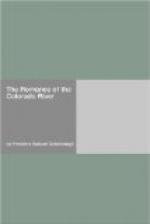This name is a substitute for the misnomer “Indian.” Its use avoids confusion.
So the river rolled on through its solemn canyons in primeval freedom, unvexed by the tampering and meddling of man. The Spaniards, after the picturesque conquest of the luckless Aztecs, were eagerly searching for new fields of profitable battle, and then they dreamed of finding among the mysteries of the alluring northland, stretching so far away into the Unknown, a repetition of towns as populous, as wealthy in pure gold, as those of the valley of Mexico whose despoiled treasures had fired the cupidity of Europe and had crammed the strong boxes of the Spanish king. And there might be towns even richer! Who could say? An Amerind named Tejo, who belonged to Guzman when he was president of New Spain, that is, about 1530, told of journeys he had made with his father, when a boy, to trade in the far north where he saw very large villages like Mexico, especially seven large towns full of silver-workers, forty days’ journey through the wilderness. This welcome story was fuel to the fire. Guzman organised a party and started for these wonderful seven cities, but numerous difficulties prevented the fulfilment of his plans, and caused a halt after traversing but a small portion of the distance. Cortes had now also returned from a visit to Spain, and he and Guzman were at the point of the sword. Then shortly arrived from the north (1536), after incredible wanderings between the Mississippi and the Rio Grande, that man of wonderful endurance, Alvar Nunez Cabeza de Vaca,* with his surviving companions, Dorantes, Maldonado, and Estevan. The latter, a negro, was afterwards very prominent by his connection with the fatal expedition sent out under the Friar Marcos to investigate the north country. The negro, if not the other men,




